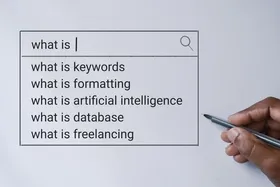AI in Search: How the History of eCommerce Site Search Led Us Here
eCommerce search evolved from exact keyword matching to AI systems that interpret shopper intent through vector embeddings and large language models.
Published November 5, 2025

eCommerce site search has evolved from primitive keyword matching to AI-powered systems that understand shopper intent. Early search boxes demanded exact terminology, forcing visitors to guess the right words or face dead ends. The introduction of faceted navigation, relevance ranking, and autocomplete marked significant progress in the 2010s.
Now, large language models (LLMs) and vector search are redefining what's possible. In this blog, we'll trace the journey from basic keyword systems to modern AI-driven search and explore how Fast Simon uses LLM technology to eliminate manual merchandising work.
» Looking to improve your on-site search? Here's how to optimize your internal search
Meet the Expert
Jameela Ghann is a seasoned online store owner with over a decade of eCommerce experience. Apart from running Alora Boutique, she's also the marketing manager for Fera Product Reviews.
eCommerce Site Search History and the Shopper Experience
Early site search was basically a single box that only worked when the shopper typed the exact words in the catalog. These primitive systems had no tolerance for typos and possessed little understanding of context.
This reliance on exact keyword matching resulted in a precarious shopper experience, often leading to frequent dead ends and increased website bounces when their wording did not perfectly match the database.
Common Challenges with Early Systems
The biggest headaches businesses faced with these early systems were language mismatch and messy data. Early engines often failed due to basic human errors, which included:
Handling typos and pluralization: The systems lacked the necessary linguistic sophistication to recognize and correct basic human mistakes like misspellings or variations.
Splitting intent across synonyms: Teams struggled when managing near-synonyms, such as terms like “hoodie” and “sweatshirt,” which often resulted in incomplete results for shoppers.
Inability to interpret natural language: Businesses faced significant challenges because the core technology lacked the ability to interpret natural language or normalize diverse product data, frequently leading to frustrating zero-result pages.
» To ensure your shoppers never hit a dead end, explore these essential troubleshooting tips for your 'No Search Results Found' page
Milestones to "Smarter Search"
Three big shifts marked the turning points from basic to smarter search.
Faceted navigation: This was the first major change, letting shoppers refine results by attributes (like color or size). Nielsen documented this in the mid-2010s as a major usability win, especially for large catalogs and on mobile devices.
Better relevance ranking: This improvement in search quality ordered results based on factors beyond just keyword presence, taking into account signals like clicks, conversions, stock status, and popularity. This improved first-result clicks and shopper confidence.
Mainstream AI adoption: The third breakthrough was the availability of AI in eCommerce, which helped drive better product retrieval across entire catalogs.
» Read more: 7 best AI solutions for eCommerce search, personalization, and merchandising
Lasting Lessons for Site Search Design
Lessons from this transition period still heavily influence how eCommerce companies design their site search today.
The Main Differences
- Autosuggest and query completion, made popular by Google, helped reduce typing errors and guided shoppers toward recognized search terms.
- Relevance ranking prioritized the most likely matches instead of relying solely on string matching.
- Smarter filters allowed shoppers to refine broad searches like “dress” by factors such as length or color, without needing perfect wording.
- Improved result tile design displayed details like availability, price, and key specs (e.g., material or hardware color), giving shoppers more confidence before clicking.
» Check out these ways to optimize eCommerce search filters
Why These Improvements Mattered
The most meaningful progress came from reducing dead-end searches and improving first-click accuracy.
What We Can Still Learn
- Displaying key decision-making attributes early (like size, color, material, and stock availability) helps shoppers self-filter efficiently.
- Autosuggest should guide users toward known catalog terms to minimize “zero-results” searches.
- Ranking algorithms should be dynamic, adapting to real engagement signals such as clicks and conversions.
- Speed and mobile usability are still important. A study by Baymard found that less than half of online stores offer a good mobile search experience.
» Here are some advantages of using an on-site search engine
The AI Era of eCommerce Site Search
AI has fundamentally redefined how site search works, moving beyond the smart search improvements of the 2010s to systems that genuinely understand shopper intent.
Modern AI Search Combines Three Core Technologies.
- Machine learning improves ranking and personalization by learning from clicks, cart activity, and conversions.
- Semantic search uses vector embeddings to match intent even when the shopper's vocabulary doesn't align with catalog terms—like finding results for "breathable summer blazer under $200."
- Large language models understand conversational phrasing and generate query rewrites or clarifications.
» See our guide to AI-based personalization
These Technologies Power Four Essential Search Functions:
- Autocomplete predicts queries using embeddings and historical search data
- Ranking prioritizes results based on engagement signals like click-throughs, purchases, and stock levels rather than keyword matches alone
- Personalization tailors results by browsing history, location, and device type—two shoppers searching "running shoes" may see different items
- Conversational interfaces rely on LLMs to interpret natural language and refine queries in real time
Constructor reported in 2025 that shoppers using site search generate 44% of total online revenue despite representing a smaller portion of traffic.
» Need more help? See our eCommerce site search best practices
Fast Simon: Smarter Search Powered by LLM AI
Before we get into what makes Fast Simon’s approach so powerful, it helps to take a quick look at how traditional search has worked up until now. Seeing where it started makes it easier to understand why AI has become such a game-changer for eCommerce search.
Why Traditional Search Falls Short
Standard, keyword-based search systems are no longer enough because they lead to:
Frustrated shoppers: A high number of visitors leave—specifically, 1 in 3 visitors leave when they cannot find what they are looking for.
Static, generic results: Traditional search fails to dynamically highlight important items like trending, high-margin, or seasonal products.
Time-consuming manual tuning: Constant adjustment of rules, synonyms, and product tags is required just to make results appear, which slows down merchandising and limits conversions.
Lost revenue opportunities: Inaccurate or irrelevant results directly reduce conversions, repeat visits, and overall revenue.
» Are you using AI in your eCommerce strategy correctly?
How Fast Simon’s AI Search Works Differently
Fast Simon employs cutting-edge AI features to conduct searches in the most human-centric way possible:
- Vector search for intent: Our vector search uses the intent behind each query rather than just keywords to find results, ensuring relevance even when the shopper's vocabulary doesn't perfectly match the product catalog.
- Multimodal search: This feature vastly enriches the search process by analyzing all relevant textual and visual media when fetching responses. It expands search capacities to include both visual and textual inputs, offering more robust and accurate results.
- AI shopping assistant: The assistant delivers personalized guidance at every step. It uses RAG Shopper Behavior Context and RAG Store Catalog Context to engage shoppers the moment they hesitate, from browsing.
Research shows that embedding-based retrieval can reduce zero-result queries while improving click-through rates. Together, these AI methods turn search from a static lookup tool into a responsive system that understands shopper intent.
» Struggling with search? Here's our guide to the Shopify search bar
Real Results with AI-Powered Search
Francesca’s, a leading women’s fashion retailer, improved its site search and filter experience using Fast Simon’s AI solutions. Shoppers can now easily sort products by color, size, style, and price, making it faster to find exactly what they want and boosting engagement and conversions.
Steve Madden uses Fast Simon’s AI search to show product thumbnails and autocomplete suggestions as shoppers type, making it easier to navigate a large catalog.
This combination helps customers quickly find styles, colors, or sizes, reduces dead-end searches, and keeps shoppers engaged, boosting add-to-cart actions and conversions.
» Here are our tips for effective site search autocomplete
FragranceBuy uses Fast Simon’s natural language processing (NLP) to understand full phrases like “summer perfumes under $50” instead of relying only on keyword matches.
By interpreting intent, not just words, their search can handle detailed queries that mix product types, descriptions, and price ranges. This smarter approach made the shopping experience feel more natural and led to a 3× increase in conversions from search.
» Confused? Here are some natural language search examples to help you understand
From Keywords to Intelligent Search
eCommerce search has evolved from basic keyword systems into intelligent engines that understand human language and intent. The shift from rigid, rule-based setups to AI-powered solutions like Fast Simon reflects how far the industry has come in meeting modern shopper expectations. Instead of forcing users to adapt to search limitations, today’s technology adapts to them—interpreting queries naturally, predicting intent, and personalizing results in real time.
With large language models and vector search driving these changes, businesses can finally move away from manual merchandising and towards automated systems that continuously learn and improve.
» Ready to enhance your eCommerce store? Browse our AI-powered eCommerce technologies
FAQs
What does AI in eCommerce search actually do?
AI in eCommerce search uses machine learning, semantic search, and large language models to understand shopper intent. It helps rank products, personalize results, predict queries, and even interpret natural language, making search more accurate and relevant.
How does AI improve autocomplete and ranking?
Autocomplete uses AI to suggest recognized queries as shoppers type, reducing errors and zero-result searches. Ranking engines use engagement signals like clicks, conversions, and stock availability to ensure the most relevant products appear first.
How does personalization work in AI site search?
Personalization tailors search results to each shopper using their browsing history, location, and device. Two people searching the same term, like “running shoes,” may see different results based on what is most relevant to them.








